Teisco
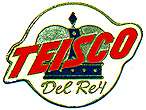 | |
Formerly called |
Aoi Onpa Kenkyūjo (1946) Nippon Onpa Kōgyō Co. (1956) Teisco Co. (1964) Teisco Shōji (1967–early 1970s) |
|---|---|
| Musical instrument manufacturing | |
| Industry | Musical instruments |
| Founded | 1946 / (1948 for brand) |
| Founder | Atswo Kaneko, Doryo Matsuda |
| Defunct | 1966 / (1969 for brand) |
| Headquarters | Tokyo, Japan |
Area served | Global |
| Brands | Teisco |
| Parent | Kawai Musical Instruments Manufacturing Co. Ltd. |
Teisco (テスコ) was a Japanese manufacturer of affordable musical instruments from 1948 until 1969, and now the brand is owned by Kawai Musical Instruments Manufacturing Co. Ltd. (河合楽器製作所; Kawai Gakki Seisakusho). The company produced guitars as well as keyboard instruments, microphones, amplifiers and even drums. Teisco products were widely exported to the United States and the United Kingdom.
Company history
The brand name "Teisco" was established in 1948, and sometimes incorrectly explained as[1] an acronym of Tokyo Electric Instrument and Sound Company.[2] However, the exact name of company establishing and producing the Teisco brand was not that name, and rather, they had frequently renamed their company.
The company was founded in 1946 by renowned Hawaiian and Spanish guitarist Atswo Kaneko and electrical engineer Doryu Matsuda. The company was originally called Aoi Onpa Kenkyujo (roughly: Hollyhock Soundwave or Electricity Laboratories). In 1956, the company name was changed to Nippon Onpa Kogyo Co., and changed to Teisco Co. in 1964. In 1967, the company was acquired by Kawai Musical Instruments Manufacturing Co. Ltd. (河合楽器製作所; Kawai Gakki Seisakusho), who discontinued the Teisco brand name for guitars in 1969 (1977 in Japan), but continued to use it for electronic keyboards until the 1980s.[3]
Products
Guitars
Teisco guitars were imported to the United States since 1959 or early 1960, and then re-badged as "Teisco Del Rey" after 1964.[4] Teisco guitars were also imported in the U.S. under several brand names including Silvertone, Kent, Beltone, Duke, Encore, Heit Deluxe, Jedson, Kimberly, Kingston, Lyle, Norma, Tulio and World Teisco. Likewise, they were imported in the U.K under such labels as Arbiter, Sonatone, Audition, Kay and Top Twenty. These brands were typically sold in large department stores, including Sears, Montgomery Ward, Woolworth (US), and Woolworth's (UK).
 |
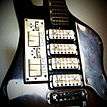 |
.png) | ||
| Hagström (ca. 1960) |
Eko (1960-1962) |
Teisco SS-4L (1962) |
Ibanez (1960s) | |
From 1948 to the early 1960s Teisco products often, like many Japanese products of the period, shared several designs with American and Western European products of the time including Hagström and EKO.[5]
 |
 |
_crop.jpg) |
 |
| Teisco MJ-2L (1963/1965) |
Teisco K4L (1966) |
Teisco Spectrum 2 (S/N 374919) |
Teisco Spectrum 2 (ca.1969) |
However, in the early 1960s Teisco products became increasingly unique. Teisco guitars became notable for unusual body shapes, such as the May Queen design resembling an artist's palette, or other unusual features such as having four pickups (most guitars have two or three). The vast amount of controls; typically an individual switch for each pickup, plus a tone or phase-cancellation switch, along with as many as five tone and volume knobs gave a wide variety of sounds yet were easily switched while playing. After Kawai bought Teisco in 1967, they started to produce all the Teisco guitars, as well as their own brand, Apollo. Hound Dog Taylor famously used a variety of these Kawai-era Teiscos, which he bought at his local Sears department store. Jim Reid of The Jesus and Mary Chain used a Spectrum V. Also, James Iha of The Smashing Pumpkins played a K-2L, which can seen in the music video for Rocket (The Smashing Pumpkins song) as well as the inside of the Pisces Iscariot CD jewel case. Ben Waugh (Scott Campbell), singer & guitarist for Apparition, The Sillies, and Scott Campbell Group played a modified ET-200 onstage and for studio recordings until it was stolen in 1985.
Many Teisco guitars had a primitive tailed bridge in their extended tail bridges with limited timbre when used in an extended technique. When the strings are attacked behind the bridge, a 3rd bridge sound is created. This is one of the reasons these guitars became popular again during the 90s among many noise artists as a cheaper alternative for the Fender Jaguar or Jazzmaster, which were beginning to attract collector interest.

Teisco EP-7
(1955 or 1964)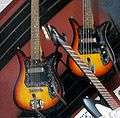
Teisco E-110 & EB-110
tulip guitar & bass (1965)
.jpg)
Teisco Vegas40
(1966)
Teisco May Queen
(1968, seems related with Vox Mandoguitar / Eko Auriga[6])

Del Rey EV-3T
(produced after Vox Phantom[7]).jpg)
Teisco EP-200 (1966) (designed after Framus Television)
Baritone guitars
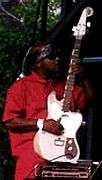
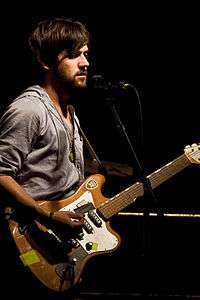
Teisco also produced a six-string bass called TB-64 (or ET-320) in 1964, similar to the Fender Bass VI which was itself an uncommon instrument. Teisco six-string bass followed an unusual body shape that was used on one of their guitars. It had an off-set body shape similar to a Jazzmaster, but with an extended top horn, a 'monkey handle' cutout on the left-facing side of the bridge and a Fender-style headstock with an oversized scroll. This instrument, as well as its regular-scale guitar equivalent, can be heard extensively on Blonde Redhead's early albums of the 90's, where they used its wide range to switch between bass and guitar melodies in the course of single songs.
Also, 2 or 4-pickup baritone guitars (27 3/4 inch scale) with a tremolo, known as Demian or Orlando VN-2 or VN-4 ca.1964 manufactured by FujiGen,[8] are often referred as Teisco models.[9][10][11] However the formal relations between Teisco and these models are not enough verified yet. The VN-2 is used by The Noble Gasses band of Los Angeles, California.
Basses
Teisco basses are easily identified through a unique pickup design exclusive to the Del Rey series. This design consisted of a large rectangular chrome pickup with black plastic holding the four poles in one place. Other designs may vary, but are all easily distinguishable and unique among subsequent bass designs. Teisco made a short scale bass under the Heit Deluxe name. With a scale length of 23.5", it was a student or beginner instrument. It featured a single pickup, volume and tone controls and a rudimentary bridge/tailpiece.
Amplifiers
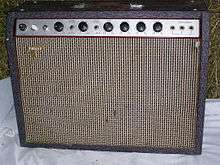
Teisco also produced numerous models of guitar and bass amplifiers which were often sold under the Checkmate brand name, but also named Teisco or Silvertone as well as Beltone and Melody. In the 1950s, early amplifier models were very basic 5-10 watt tube/valve designs. During the 1960s, more advanced and powerful models were offered, such as Checkmate 25, Checkmate 50,and Checkmate 100 featuring dual channels, reverb and tremolo effects. Teisco also made solid-state (transistor-based) models, some designed no less radically than their guitars of the time. The Sound Port 60 (60 watts/RMS) and Sound Port 120 (120 watts/RMS) amplifiers from the late 1960s were copies of Fender's silverfaced Vibro Champ and Twin Reverb.
Synthesizers
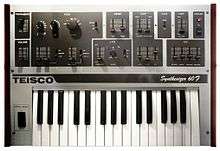
Teisco also produced a range of synthesizers, with models including the 60F, 110F, 100F, 100P, SX-210, SX-240, and SX-400.
Bands such as Hot Chip (UK), Pure Reason Revolution (UK), and Goose (Belgium) are known to use Teisco synthesizers.
Drums
Teisco marketed drum sets in limited sizes and configurations during the 1960s, sold under the brand name Del Ray. They were produced by sub-contractors to fill out the company's catalog as a supplier of combo instruments,[12] but discontinued after the acquisition by Kawai.
References
- ↑ Mark Cole (12 December 2006). "Teisco timeline". Teisco Twanger's Paradice.
1948 - The Teisco brand arrives! The brand name was coined by Mr. Atswo Kaneko and does not stand for the 'Tokyo Electric Instrument and Sound Company' as is thought by some.
- ↑ Dregni, Michael; Aldrich, Margret; Murray, Charles Shaar; Voyageur Voyageur Press (19 September 2003). This Old Guitar: Making Music and Memories from Country to Jazz, Blues to Rock. MBI Publishing Company LLC. p. 134. ISBN 978-1-61060-549-6.
... "Teisco" was an anagram for the Tokyo Electric Instrument and Sound Company or something along those lines.
- ↑ 60's Bizarre Guitars 1993
- ↑ Michael Wright. "Jack Westheimer — Pioneer of Global Guitarmaking". Vintage Guitar (July 1999).
... no one has had a bigger impact on the globalization of guitars than Mr. Jack Westheimer — one of the pioneers of global guitarmaking. Among the brands associated with his activities are Kingston, Teisco, Teisco Del Rey, Silvertone, Emperador, Cortez, and Cort, ...”, “In late '59 or early '60, Westheimer also began to import Teisco electric guitars made by Teisco in Japan. These earliest Teiscos were plain Teisco-brand (not Teisco del Rey).”, “A number of key events converged in '64. ... Also, Westheimer changed the name of the Teisco guitars he was importing to Teisco del Rey, the brand most commonly seen. ”, “Weiss Musical Instruments (W.M.I.): The forte of W.M.I. was flash design and marketing. The fancier Teiscos with the striped metal pickguards and colorful finishes generally date from the later 1960s and were done in conjunction with W.M.I., not Westheimer.
- ↑ To solve the questions about the design similarities across the multiple manufacturers, more intensive verifications on the international guitar supplying networks and the role of international distributors at that era, are expected. As one possibility, the involvement of Goya, a sales company of Levin Guitar in the United States, may be significant; Hagström, Eko, and Greco (FujiGen) were known to had been supplied to Goya; and Teisco's similar models might have some relations to them.
- ↑ "Eko Auriga 1969/1971". FetishGuitars.com. Archived from the original on 2012-04-25.
- ↑ US patent D208948, Thomas W. Jennings, "GUITAR", issued 1967-10-17, assigned to Warwick Electronics Inc.
- ↑ "Genesis of FujiGen (start of the electric guitar manufacturing)". Matsumoto guitars (Guitar Manufacturers in Matsumoto City) (in Japanese). Matsumoto: Junk Guitar Museum.
In the first half of the 1960s, FujiGen had subcontracted with Teisco, and manufactured models including: J-1, J-2, EB-1 (similar to EB-18), VN-2, and VN-4; And then, their former factory manager had spin-out to establish a Teisco factory in Toyoshina, called Teisco String Instruments, Company (also known as Matsumoto Teisco). - ↑ Bertram D (22 November 2009). "1966 Teisco Demian Baritone VN-4". Guitarz.blogspot.com.
- ↑ Mark Cole (December 12, 2006). "Solid body six strings - 2 pickups". ID Parade, Teisco Twangers.
- ↑ Mark Cole (December 12, 2006). "Solid body six strings - 4 pickups". ID Parade, Teisco Twangers.
- ↑ "Teisco Catalog 1968".
- Models and Catalogs
- Teisco timeline by Mark Cole
- Teisco catalog 1964-1965, Nihon Onpa Kōgyō, Co. (日本音波工業)
- Teisco catalog 1965 by Yamaha
- Teisco catalog 1965-66, Teisco Co.
- Teisco catalog 1966, p. 1, 2–3, Teisco Co.
- Teisco catalog 1967, Teisco Shōji, Co. (テスコ商事)
- Teisco catalog 1968 (publisher unknown)
- New Sounds In Music - Solid State Effect Guitars (late 1960s), Teisco Shōji, Co. (テスコ商事)
- Teisco catalog 1974/05, Kawai/Teisco
- Teisco catalog 1980, Kawai/Teisco
- Teisco catalog 1982, Kawai/Teisco
- Bibliography
- OUTPUT. Y.M.M. Player Magazine mook (in Japanese). Tokyo: Player Corporation. 1982-01-20. ID:09818-1-20. External link in
|publisher=(help) - 60's Bizarre Guitars. Guitar Magazine mooks / Rittor Music mook (in Japanese). Tokyo: Rittor Music, Inc. 1993-03-01. ID:4-69771-02, OCLC 269873814, ASIN B0064YESZO.
The history described on this book is widely referred (for example, "Teisco catalog 1974/05"., etc), but this book itself has been discontinued for a long time. - Meyers, Frank (2015). History of Japanese Electric Guitars. Centerstream Publications. ISBN 978-1-57424-315-4.
Further reading
- Wright, Michael. "Teisco Guitars, Part I - Rock 'n' Roll Dreams, Part I". Vintage Guitar.
- Wright, Michael. "Teisco Guitars, Part II - Rock 'n' Roll Dreams, Part II". Vintage Guitar.
- Wright, Michael. "1968 Teisco May Queen - Perennial Classic, Made in Japan". Vintage Guitar (July 2003).
- Wright, Michael. "Spectrum 5". Vintage Guitar.
- Moseley, Willie G. "Teisco Del Rey Basses - '60s Egalitarianism from Japan". Vintage Guitar (October 2014).
External links
| Wikimedia Commons has media related to Teisco. |
- Teisco Twanger's Paradise, a site for Teisco collectors
- VintAxe.com, features pictures and descriptions of Vintage Teisco Guitars. Must pay for access.
- Japanese Page on King of Kays - information and photos of vintage Japanese electric guitars at KingofKays.com
- Teisco synthesizers pages, with information on various models of Teisco synthesizers
- Vintage Synth Explorer: Teisco synthesizers
- Teisco synthesizer & Sequencer, Sequencer.de
- Teisco Amps